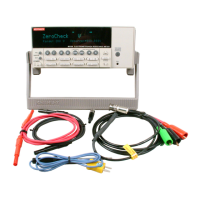3-8 Remote Operation Model 6517A Getting Started Manual
SCPI command syntax
Tree structure
SCPI commands are organized in a tree structure, similar to disk directories in computer
operating systems. Each subdirectory is called a subsystem. For example, part of the
SENSe1 subsystem is listed below and shown in Figure 3-2.
[SENSe[1]]
:DATA?
:FUNCtion <name>
:VOLTage
[:DC]
:RANGE
[:UPPer] <n>
:AUTO <Boolean> | ONCE
:REFerence <n>
:STATe <Boolean>
:ACQuire
Figure 3-2
Hierarchy of the example SENSe1 commands
A command summary table is a way of documenting SCPI commands, but it does not
show complete command names. A complete command is formed by joining the compo-
nents. For example, the complete :STATe command in the example is:
SENSe1:VOLTage[:DC]:REFerence:STATe
Note that square brackets are not part of the command; they indicate optional parts of the
command.
This hierarchical approach permits the same command to be used many times. For exam-
ple, many subsystems contain a :STATe command, but each one is unique because the
complete command is unique. This is analogous to having a file named INDEX.TXT, for
example, in each directory of your computer's hard disk. Although the files have the same
name, they are unique because they are each in a different directory.
:REFerence
SENSe1
:DATA? :FUNCtion :VOLTage
[:DC]
:RANGe
:ACQuire[:UPPer] :AUTO :STATe

